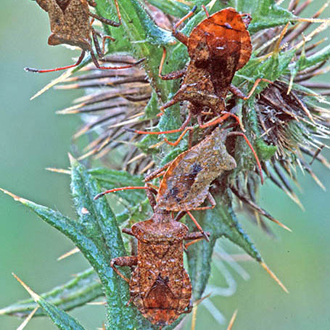

|
 |
 |
 |
 |
 |
 |
 |
 |
|
Bugs of one sort or another, Hemiptera and Heteroptera, are plentiful in woodland and shieldbugs are among the most easily seen as well as most endearing. This may be thanks to their variety of colouration and the apparently clumsy way virtually all of them fly and some of them move, especially when dropping out of sight off foliage when disturbed. Some are predators, some are not. Generally the group is doing well, with arrivals from mainland Europe and an But showing an adaptability matched by that of the Box Bug (see Gardens section), the Juniper Shieldbug has taken to using Lawson's cypress which, unlike the related Leyland Cypress, produces the cones the shieldbug requires. Stable species in numbers include the Forest Bug (Pentatoma rufipes, 14mm), found principally on Oak (Quercus sp), the Sloe Bug (Dolycoris baccarum, 11mm), which despite its name is not a specialist feeder and can be seen on many different plants, and the Dock Bug (Coreus marginatus, 13mm). The last-named, which breeds mainly on Docks and Sorrel (Rumex spp), is one of the commonest of all the group though it is not a genuine shieldbug. The robust antennae with four segments place it among the Coreidae or Squash Bug family. Parent Bugs (Elasmucha grisea, 8mm), which use Birch or Alder trees, are some of the most intriguing of the shieldbug family. Uniquely the female sits over her eggs and One Rhopaloid bug, Rhopalus parumpunctatus, is shown in the Heathland section but Rhopalus subrufus (7mm) is less particular in its requirements. Though commonest on chalk, it may be found in woodland rides and clearings or indeed anywhere with flower-rich grassy banks. Not all shieldbugs are herbivores and the Bronze Shieldbug (Troilus luridus, 10mm) resembles the Blue Shieldbug shown on the Downland invertebrates page in being a fierce predator. It is a fairly common species equally at home in broad-leaved and coniferous woodland, catching principally leaf beetles, although prey as tough as ladybirds can be taken. As the images above indicate, adults, which are seen mostly in August and September, are nothing like so colourful as the nymphs, whose brightness is perhaps the basis of the scientific name. Common Froghoppers (Philaenus spumarius) are bugs and capable of jumping The ground bug Aphanus rolandri (8mm) is a scarce, fast-running, sun-loving species active in a good year, notably 2005, from March to October. Ant Damsel Bugs (Himacerus mirmicoides, 8mm), which get their English name from the way the larva closely resembles an ant, are predators that eat almost anything smaller than themselves. This includes aphids, which helps give these insects a good name among farmers cultivating crops. Images © Jeremy Early. All rights reserved. In 2013 I published My Side of the Fence - the Natural History of a Surrey Garden. Details may be found, and orders placed, via this hyperlink My Side of the Fence. In November 2015 Surrey Wildlife Trust published the atlas Soldierflies, their allies and Conopidae of Surrey, jointly written by David Baldock and me. Details are on this web page: Atlas. |